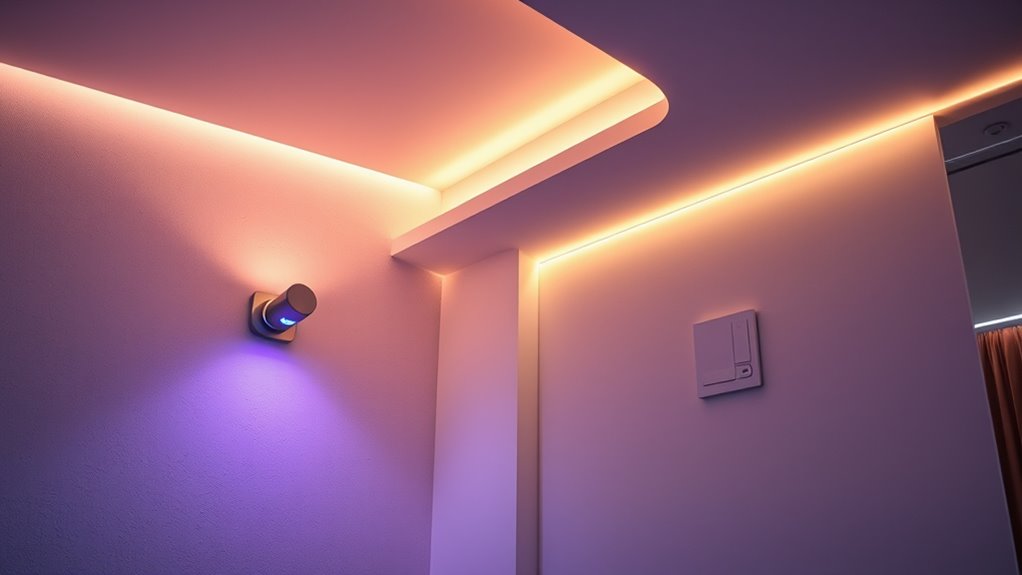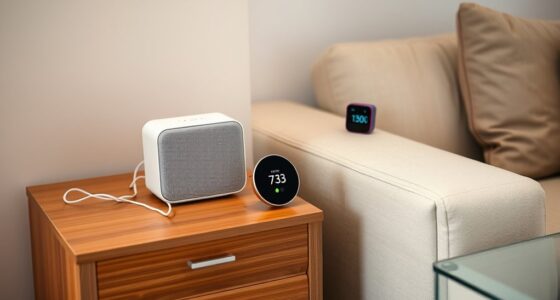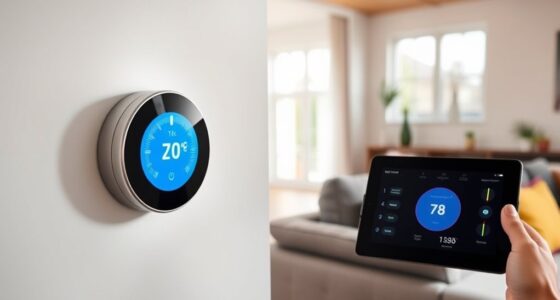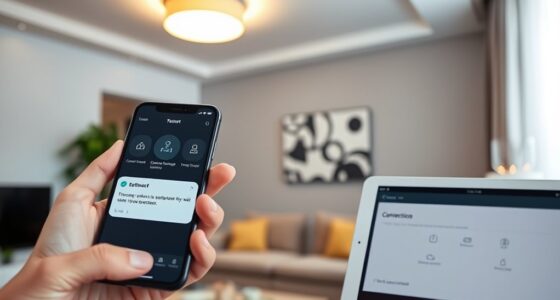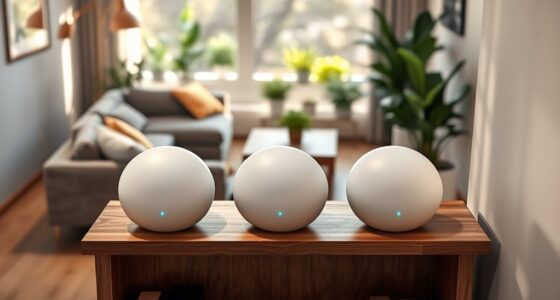Smart lighting lets you control your apartment’s lights remotely or automatically with bulbs, strips, and switches that connect via Wi-Fi, Zigbee, Z-Wave, or Bluetooth. You can change colors, dim lights, set schedules, and automate scenes to create the perfect mood or save energy. Smart switches replace traditional ones, giving you centralized control, while smart plugs let you turn any device on or off remotely. Explore how to choose and set up these devices for a smarter home experience.
Key Takeaways
- Smart bulbs, strips, and switches enable remote control, automation, and customization of your apartment lighting via Wi-Fi, Zigbee, Z-Wave, or Bluetooth.
- Smart bulbs support color-changing, dimming, and scheduling features, offering personalized ambiance and energy savings.
- Smart switches replace traditional wall switches, allowing remote control and automation of existing fixtures without replacing bulbs.
- Smart LED strips provide flexible, color-changing lighting options for accentuating spaces and creating dynamic atmospheres.
- Integrating these devices with voice assistants and home automation platforms enhances convenience and simplifies management.
Understanding the Basics of Smart Lighting
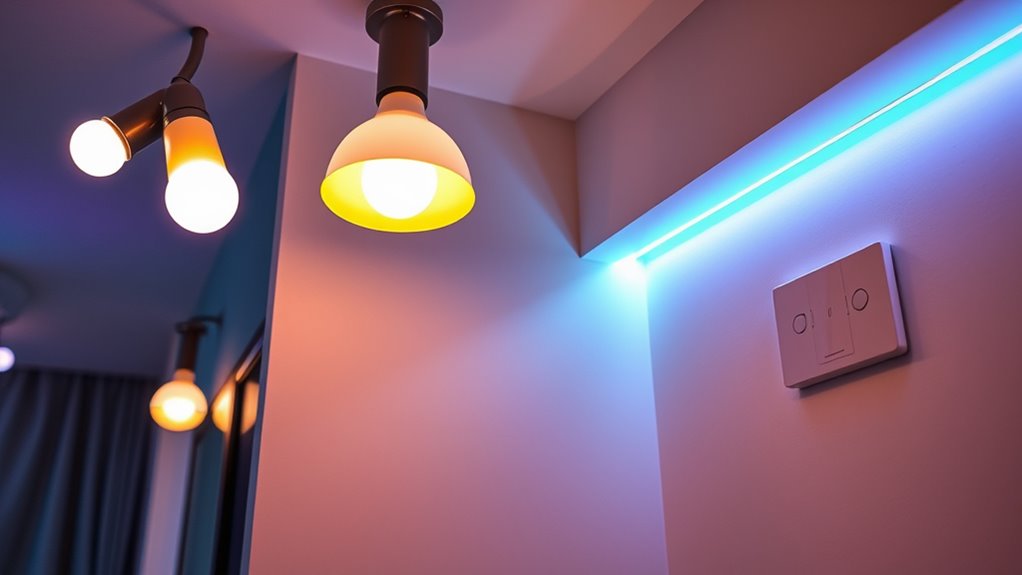
Smart lighting systems leverage wireless technologies like Wi-Fi, Zigbee, Z-Wave, or Bluetooth to let you control and automate your lights remotely. These systems include smart bulbs, smart switches, LED strips, and hubs, each offering different control options and installation complexity. High performance projectors are also designed to integrate with smart home systems for a seamless entertainment experience. Smart bulbs are versatile; they can change colors, dim, and schedule on/off times, often supporting millions of colors and tunable white. Smart switches replace traditional switches, allowing you to control existing fixtures remotely and support features like dimming and voice commands. Wireless control guarantees seamless integration with platforms like Alexa, Google Home, or Apple HomeKit. Understanding these basics helps you choose the right components for your setup, making your lighting smarter, more flexible, and easier to manage. Additionally, knowing the individual components and their capabilities ensures you can create a customized and efficient smart lighting environment that caters to your specific needs. Recognizing the importance of industry trends can also help you stay updated on new features and compatible devices, ensuring your system remains current and expandable. Moreover, staying informed about AI security vulnerabilities can help you protect your smart lighting system from potential cyber threats.
Different Types of Smart Lighting Devices
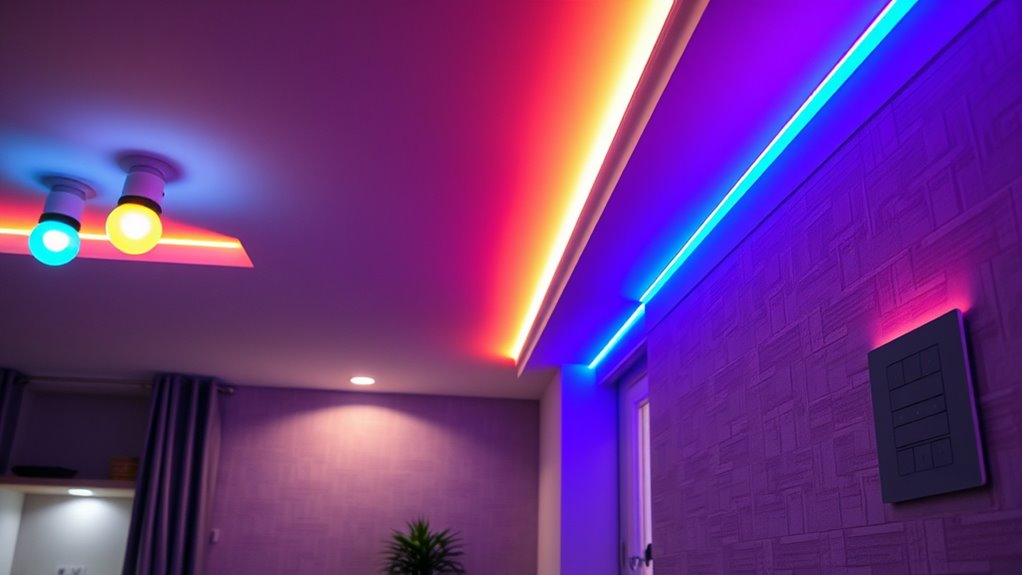
There are various smart lighting devices to choose from, each with unique features and control options. You can pick from smart bulbs that change colors, flexible LED strips for decoration, or switches that automate existing fixtures. Paint Sprayer Reviews & Buying Guides also highlight the importance of choosing compatible devices and understanding their specific functionalities to ensure seamless integration into your smart home setup. Incorporating rustic lighting like chandeliers or pendant lights can add character to your space and complement other farmhouse elements. Additionally, automation technology in smart lighting allows for customized schedules and remote control, enhancing convenience and energy efficiency. The integration of bicycle lighting systems ensures safety during nighttime rides and can be automated for convenience, demonstrating how adaptable lighting solutions can serve various needs. Moreover, understanding the effectiveness of eye patches can help you select the right skincare tools for your routine, ensuring optimal results. Outdoor smart plugs also let you control exterior lights and appliances easily and reliably.
Smart Bulb Varieties
Smart bulb varieties include several types, each offering different installation methods and control options to suit your needs. Wi-Fi smart bulbs are popular because they’re affordable and easy to set up, connecting directly to your home network without extra hubs. These bulbs often support color-changing features, letting you customize your lighting with millions of colors and tunable white light to match your mood or activity. Recognizing soulmate angel numbers can also help you find harmony and positive energy in your living space, enhancing your overall environment. Other options, like Zigbee and Z-Wave bulbs, require a hub but provide more reliable connections and broader compatibility across smart home systems. Brightness levels vary, from around 450 lumens for standard use to over 1600 lumens for larger rooms. When selecting your smart bulbs, consider lighting control systems that integrate seamlessly with your existing devices to simplify management. Additionally, choosing bulbs with energy-efficient features can help reduce electricity consumption and save money over time. Incorporating smart lighting automation can further enhance convenience and ambiance, allowing your lights to adapt automatically to your routines or preferences. For example, some smart bulbs are designed to work with smart home hubs, which can expand your automation options and connectivity. Whether you want simple control or vibrant ambiance, there’s a smart bulb variety to fit your preferences.
Control Device Options
When it comes to controlling your lighting, you have several device options that cater to different preferences and setup complexities. Smart switches are a popular choice; they replace traditional wall switches and allow you to control existing fixtures remotely or automate them without changing bulbs. They are ideal for seamlessly integrating your lighting with other smart home systems. Smart bulbs, on the other hand, are wireless and install directly into your fixtures, offering features like color-changing and dimming, all controlled via apps or voice commands. They provide flexibility for individual fixture customization. Smart plugs provide a simple control option for lamps and other plug-in devices, giving you smart features without rewiring. Your choice depends on how much control you want, the level of customization, and whether you prefer controlling individual bulbs or entire fixtures. Each device offers unique benefits to suit your setup. Additionally, some smart lighting options include energy-efficient features that can help reduce electricity consumption and support well-being by creating calming environments. Incorporating energy-efficient lighting can further enhance your home’s sustainability and reduce costs, especially when selecting devices with automated scheduling to optimize usage times. Moreover, many smart lighting devices can be integrated with home automation systems, allowing for more comprehensive control and customization. Using these devices can also help you better understand and manage your energy usage to promote a more sustainable lifestyle.
Outdoor Lighting Solutions
Outdoor lighting solutions have advanced to include weatherproof smart devices that enhance both security and ambiance. With weatherproof outdoor lighting, you can remotely control garden spike lights, floodlights, and string lights using an outdoor smart plug or smart outdoor switches. Security lights with motion sensors and integrated cameras can be scheduled or triggered via smartphone apps, adding convenience and safety. Installing weather-resistant smart plugs and switches simplifies automation without rewiring, ensuring safe operation in any weather. Compatibility with platforms like Alexa, Google Assistant, and Apple HomeKit makes managing your outdoor lighting seamless. According to hours today list, many stores that sell smart outdoor lighting have flexible hours and online shopping options to fit your schedule. Weatherproof outdoor devices are designed to withstand various weather conditions, ensuring durability and reliable operation year-round. Additionally, selecting weatherproof outdoor lighting that meets IP ratings guarantees protection against dust and water, further enhancing durability.
How Smart Bulbs Enhance Your Home Environment
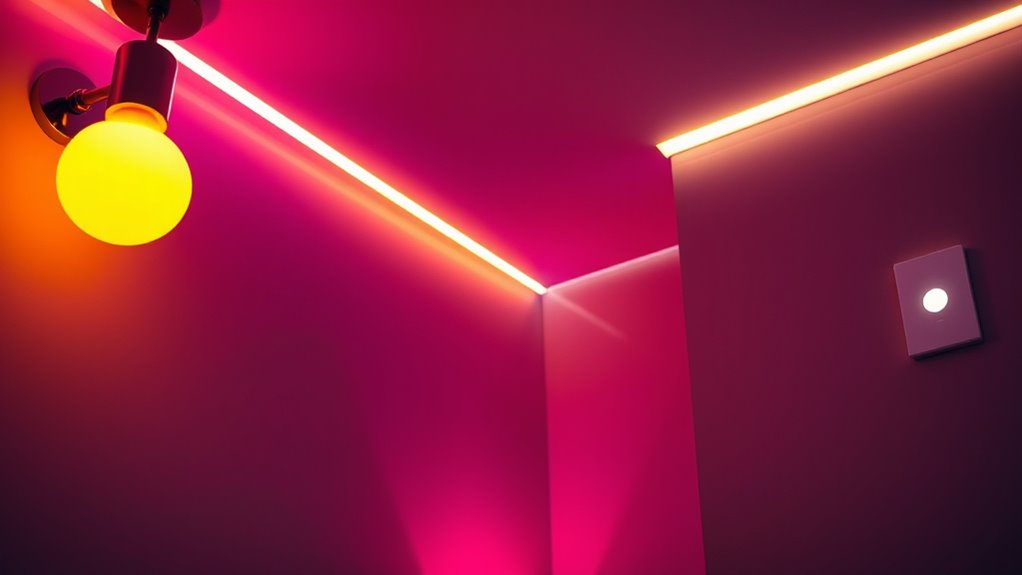
Ever wondered how to instantly transform the mood of any room? Smart bulbs make it easy by allowing you to customize your home lighting with just a tap or voice command. They can change colors and adjust brightness remotely, creating the perfect ambiance for any occasion.
With a lifespan of up to 25,000 hours, they offer years of maintenance-free use. Compatible with voice control devices like Alexa, Google, and Siri, smart bulbs let you switch lights on or off without lifting a finger.
Many also support scheduling and automation, so your lights can turn on when you arrive home or dim at bedtime automatically. Installing them is simple—just replace your existing bulbs with standard screw-in fittings and connect through an app.
The Role of Smart Switches in Home Automation
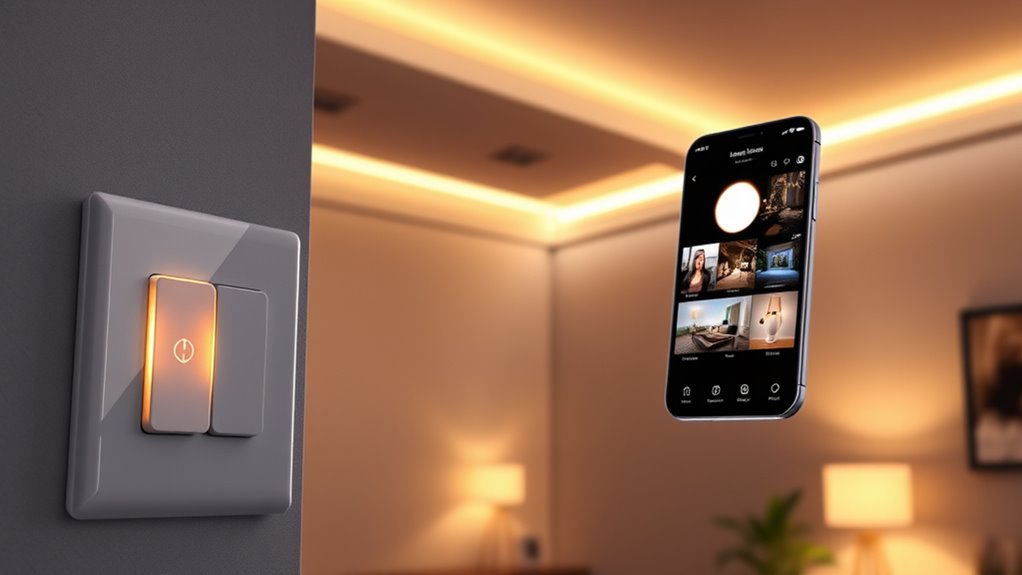
Smart switches give you seamless control over your lighting, allowing you to manage multiple fixtures easily through your smartphone or voice commands.
They enhance automation by staying powered on, ensuring routines run smoothly even if you manually turn off a switch.
Plus, with compatibility across major platforms and straightforward installation, smart switches are a versatile addition to your home.
Seamless Wall Control
Have you ever wondered how home lighting can be both effortless and fully customizable? Smart switches make this possible by replacing traditional wall switches for seamless wall control. They let you manage lighting through apps, voice commands, or automation, offering wireless control without needing to replace bulbs. Unlike standard switches, smart switches stay powered on, ensuring your lighting control remains consistent even when physically turned off. This prevents control loss and keeps your automation functioning smoothly. You can schedule, dim, and sync your lights with your smart home ecosystem, creating a truly integrated experience.
| Feature | Benefit | Compatibility |
|---|---|---|
| Wireless control | Control from anywhere | Alexa, Google, Apple |
| Stay powered on | Continuous automation | All smart switches |
| Custom schedules | Personalized lighting scenes | Compatible with existing wiring |
Enhanced Automation Capabilities
Smart switches play a pivotal role in home automation by enabling centralized control of multiple smart bulbs across rooms or zones. With smart switches, you can automate lighting schedules, set routines, and adjust lighting based on occupancy or security triggers.
Unlike regular switches, smart switches stay powered on, allowing continuous remote control even when physically toggled off. They support integration with voice assistants and smart home platforms, making automation seamless.
Installing smart switches may require wiring updates, but they eliminate the need to replace individual bulbs, simplifying advanced automation. By overriding traditional switches, smart switches ensure consistent control, boosting energy efficiency, home security, and convenience.
They truly elevate your lighting system into a fully integrated, automated part of your smart home.
Compatibility and Installation
Integrating smart switches into your home automation system requires careful attention to compatibility and proper installation. Not all smart switches work with every smart home platform, so check compatibility with your preferred system like Alexa, Google Home, or Apple HomeKit.
Proper installation is essential; many smart switches need wired connections and may involve complex circuits, making professional help advisable.
Unlike traditional switches, smart switches maintain power to bulbs even when physically off, allowing continuous smart control.
They can handle multiple fixtures on a circuit, ideal for whole-room or outdoor lighting automation.
Ensuring compatibility and correct installation guarantees your smart switches function seamlessly, providing reliable remote control, automation, and scheduling capabilities for your existing lighting setup.
Advantages of Using Smart Plugs for Lighting Control
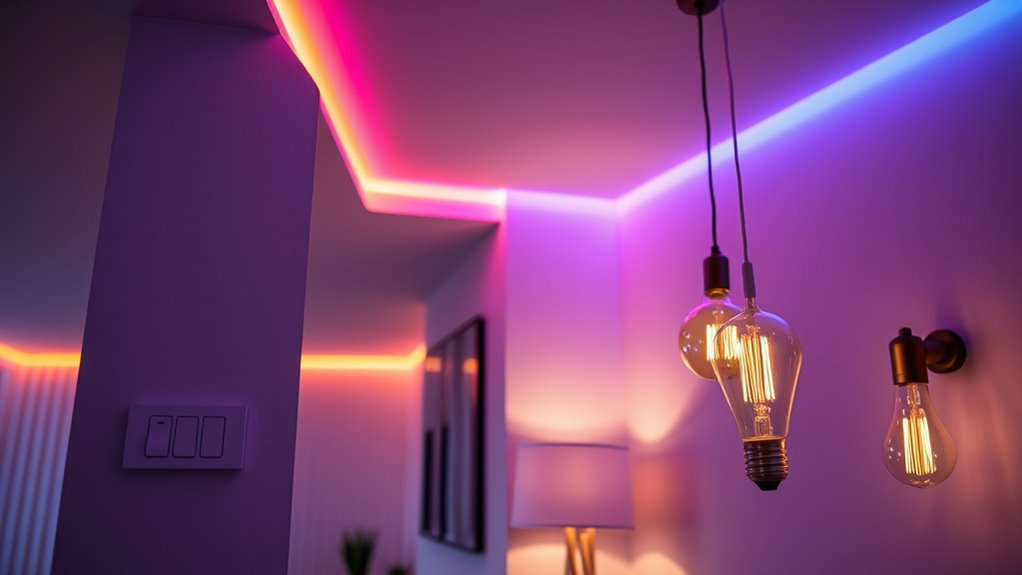
Using smart plugs for lighting control offers a simple and cost-effective way to update your existing fixtures without the hassle of rewiring. They let you remotely turn lights on and off, set schedules, and automate lighting via your smartphone, boosting convenience and energy efficiency.
Outdoor weatherproof smart plugs make managing garden lights or string lights safe and easy, without complex wiring. You can also support dimming and scene settings when paired with compatible bulbs, expanding your lighting options.
- Control outdoor and indoor lighting remotely
- Save energy with scheduled on/off times
- Easily add dimming and scene features
With smart plugs, you get flexible lighting control that’s affordable and straightforward, helping you save energy while enhancing your space’s ambiance.
Choosing the Right Protocol for Your Smart Lighting System

Choosing the right protocol for your smart lighting system is essential to guarantee reliable performance and easy management. Your choice affects compatibility with other smart home devices, setup complexity, and long-term reliability.
Wi-Fi smart bulbs are affordable and simple to install but can face latency issues in larger networks.
Zigbee and Z-Wave are mesh protocols that extend network range and improve reliability, especially in multi-room setups, but require dedicated hubs or bridges.
The Thread protocol, compatible with the upcoming Matter standard, offers fast, dependable performance without proprietary hubs, using border routers like Apple HomePod Mini or Google Nest hubs.
Ultimately, your choice balances initial cost, ease of setup, and future-proofing, ensuring seamless integration across your smart home ecosystem.
Installing and Setting Up Smart Lighting Components
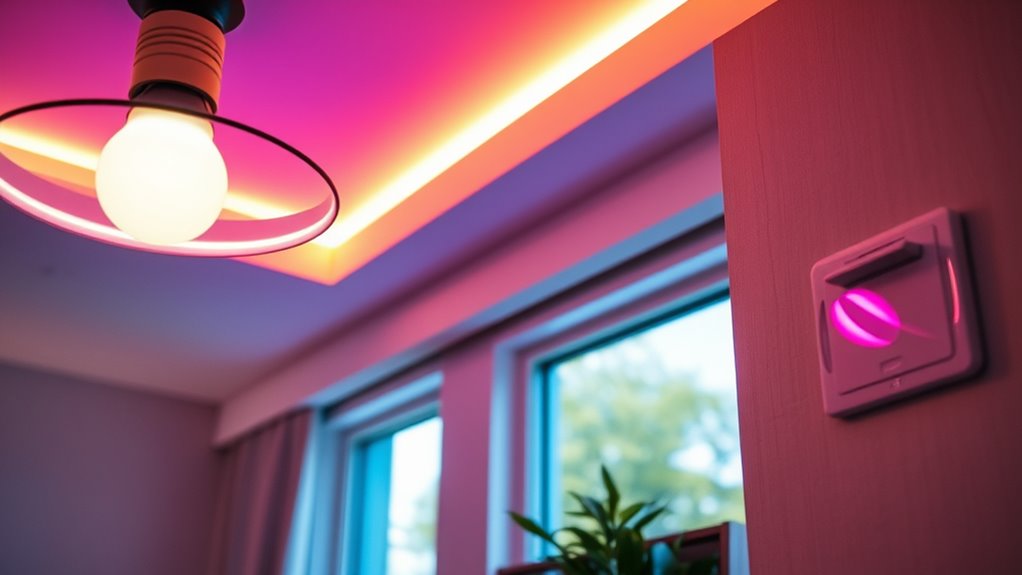
Installing and setting up smart lighting components is a straightforward process that begins with replacing your existing bulbs, switches, or fixtures with compatible smart devices, following the manufacturer’s instructions.
For smart bulbs, simply screw them into standard sockets and connect via Wi-Fi using the app.
Smart switches may require wiring replacement and a neutral wire; professional installation is recommended for complex setups.
Connecting your devices involves pairing them through the manufacturer’s app, often by following step-by-step prompts.
Proper setup also includes assigning device names, configuring schedules or scenes, and performing firmware updates for best performance.
- Choose the right location for your smart switches and bulbs
- Follow manufacturer instructions carefully during installing
- Use the app to finalize setup and customize your lighting
Features and Benefits of Modern Smart Lighting Solutions

Modern smart lighting solutions enhance your home by offering a wide range of customization options and seamless control. With smart bulbs and lighting systems, you can change colors with millions of hues, adjust white temperature, and set brightness levels to create the perfect ambiance.
They also support scheduling and automation, mimicking natural light patterns to improve your sleep and save energy. Integration with platforms like Alexa, Google Home, and Apple HomeKit makes voice control simple, letting you turn lights on or off and adjust settings hands-free.
Many smart lighting products use advanced protocols like Zigbee, Z-Wave, or Matter for reliable, future-proof connectivity. These features not only boost convenience but also help you save energy—up to 75%—and enhance your home security through occupancy simulation.
Tips for Optimizing Your Smart Lighting Experience
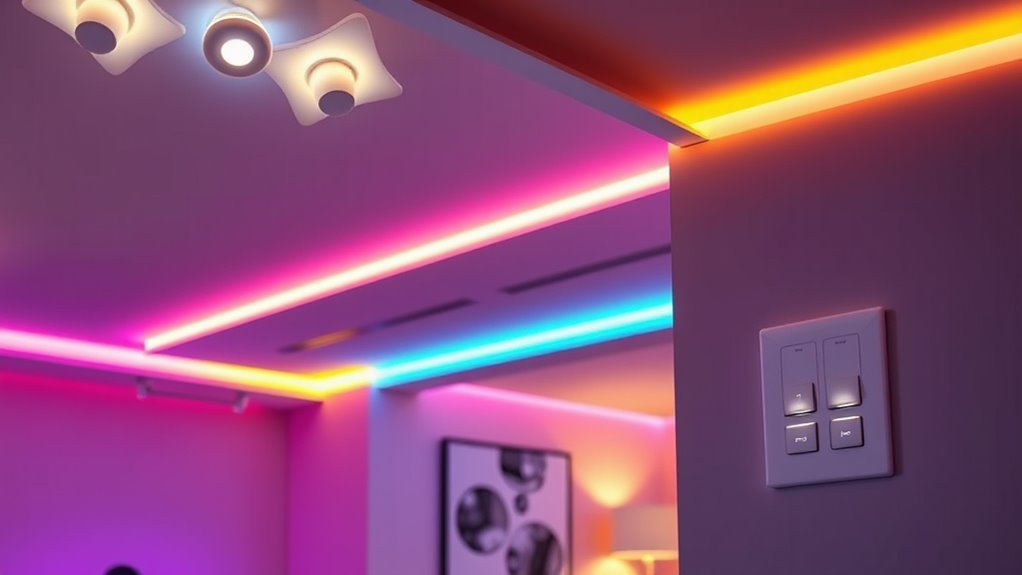
To get the most out of your smart lighting system, making certain of seamless integration and future-proof your setup is essential. Use a smart hub or select Matter-compatible devices to ensure all your smart bulbs, smart switches, and lighting components work smoothly together.
Place motion sensors strategically and set schedules to maximize energy savings and security, especially in entry areas.
Experiment with different color temperatures and scenes to craft the perfect ambiance and support your circadian rhythms.
Regularly update your smart lighting app and firmware for access to new features, improved reliability, and security.
Label your devices within the app to simplify management, especially when controlling multiple bulbs, strips, and switches, making your lighting setup more efficient and enjoyable.
- Use a central hub or Matter-compatible devices for seamless integration
- Schedule and place sensors to optimize energy savings and security
- Regularly update your app and firmware for better performance
Frequently Asked Questions
Can You Use Smart Bulbs and Smart Switches Together?
Yes, you can use smart bulbs and smart switches together, but keep in mind that the switch controls the power. If you turn it off, smart bulbs lose power and can’t be controlled remotely or change colors.
To get the best experience, keep the switch in the “on” position or choose smart switches designed for use with smart bulbs. This way, you maintain full control and enjoy your smart lighting features.
What Is the Difference Between a Smart Bulb and a Smart Switch?
You ask about the difference between smart bulbs and smart switches—sounds like a simple quest, right? Well, it’s like choosing between a fancy lamp and a wall full of switches.
Smart bulbs screw into your fixtures, giving you control over color and brightness without rewiring. Meanwhile, smart switches replace your old switches, controlling multiple bulbs or fixtures, and sometimes overriding smart bulbs’ settings.
It’s all about what kind of control you crave.
What Are the Disadvantages of Smart Light Bulbs?
You’ll find smart light bulbs can be pricey, often costing more than traditional ones. They rely on Wi-Fi, which can cause lag or connectivity issues if many devices are active.
Some bulbs flicker, dim, or stop responding if firmware isn’t updated regularly. They also need constant power, so installing them in fixtures controlled by switches can be tricky.
Over time, they may fail or need replacement, adding to your costs.
Do Smart Light Bulbs Raise the Electric Bill?
Imagine a tiny spaceship hovering nearby—smart bulbs use minimal power, so they won’t skyrocket your electric bill.
You might worry about extra costs, but these LED bulbs consume less energy, especially with dimming and automation. You’ll actually save money over time because they’re efficient and reduce unnecessary lighting.
Conclusion
Think of your smart lighting system as a symphony conductor guiding your home’s ambiance. Each bulb, strip, and switch plays a note, creating a harmonious environment tailored to your mood. When you choose the right devices and protocols, you’re composing a masterpiece of convenience, comfort, and style. With a little setup, your apartment transforms into a living canvas, where light responds effortlessly to your commands—turning everyday spaces into personalized works of art.
